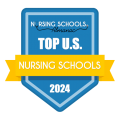For our 2024 rankings, the research team at Nursing Schools Almanac collected data on nearly 3,000 nursing schools and campuses throughout the United States. We evaluated each school on three dimensions:
Search for nursing schools and programs in your state:
With a population of less than 3.6 million, Connecticut is one of the smallest states in the U.S. What’s not so small about the Constitution State is its growing nursing community. Connecticut is home to more than 66,000 nurses working in critical frontline roles like registered nurse (RN), licensed practical nurse (LPN), and certified nursing assistant (CNA).
Nursing is the largest profession in Ohio. The state is home to more than 240,000 licensed nursing professionals. The vast majority of these nurses fill one of three roles: registered nurse (RN), licensed practical nurse (LPN), and certified nursing assistant (CNA). The education and licensure requirements, and the underlying job responsibilities, vary substantially by role.
The Vineland-Bridgeton metropolitan area of New Jersey is home to more than 3,000 nurses. The most common roles are registered nurse (RN), licensed practical nurse (LPN), and certified nursing assistant (CNA). Many of these professionals completed their education at a local nursing school such as Cumberland County College, Vineland Adult Education Center, or Cumberland County Education Center.
Utica, Rome, and the surrounding metropolitan area of upstate New York have a large community of nurses. All told, the region is home to 2,860 registered nurses (RNs), 1,470 licensed practical nurses (LPNs), and 2,330 certified nursing assistants (CNAs). Many of these healthcare professionals earned their certificate, diploma, or degree at a local school.
If you would like to become a nurse in Tuscaloosa, Alabama, the first step is to decide which program matches your goals. For example, aspiring registered nurses (RNs) can pursue one of four pathways: a hospital diploma, an associate’s degree in nursing (ADN), a bachelor of science in nursing (BSN), or a direct-entry master of science in nursing (MSN). All four pathways prepare candidates to sit for the National Council Licensure Examination (NCLEX-RN), a requirement for licensure.
The metropolitan area of Topeka, Kansas, has more than 6,000 licensed nursing professionals. The vast majority fall into one of three common nursing roles: registered nurse (RN), licensed practical nurse (LPN), and certified nursing assistant (CNA). These healthcare professionals often earned their certificate, diploma, or degree at a local school, like Washburn University or Washburn Institute of Technology.
Arizona is home to more than 75,000 nursing professionals across a broad range of roles, including registered nurse (RN), licensed practical nurse (LPN), and certified nursing assistant (CNA). Hundreds of these professionals work in Tempe, Arizona’s eighth-largest city. Many of Tempe’s nurses earned their degree or certificate at a local nursing school. The most prominent local option is Arizona State University, of course, but accredited schools like Brookline College and University of Phoenix also have nearby campuses.
Healthcare and social assistance workers make up 12 percent of Virginia’s labor force. The state’s hospitals and health systems contribute $38 billion annually to the local economy. With such a significant and positive impact, it’s not surprising that one of the largest forces within Virginia’s healthcare system is the nurse population.
With a population of more than 12,000 registered nurses (RNs), South Dakota has the second-highest per-capita concentration of RN jobs in the nation. The state is also home to a large number of licensed practical nurses (LPNs) and certified nursing assistants (CNAs). Nursing professionals across all three roles are in high demand across the state. This is especially true in South Dakota’s largest city, Sioux Falls.
A rewarding nursing career begins with a degree, diploma, or certificate from an accredited nursing school. Fortunately, the Salem-East Liverpool area of Ohio offers easy access to accredited schools with a breadth of nursing programs. Some noteworthy options include Kent State University’s Columbiana County campus, Columbiana County Career & Technical Center (CCCTC), and the Hannah E. Mullins School of Practical Nursing (HEMSPN).















